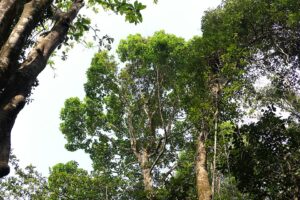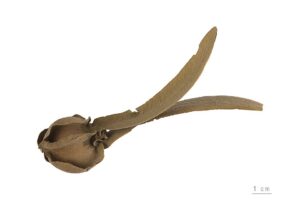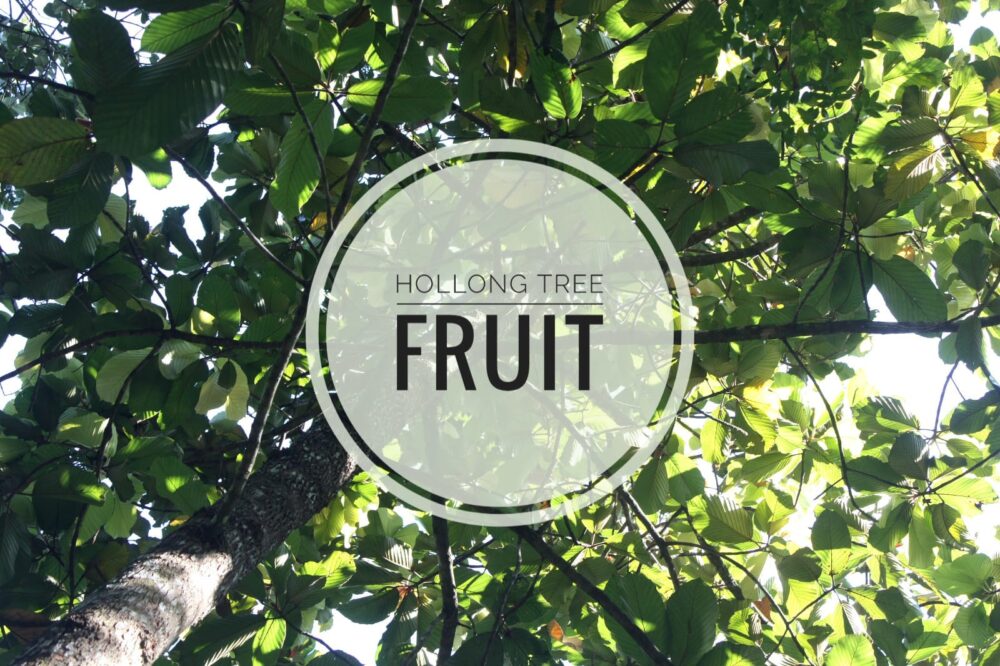Hollong tree fruit has always fascinated me. I remember standing under a tall Hollong tree during a trip to Assam, watching its shiny green leaves shimmer in the sunlight while a few fruits dropped gently to the ground.
Their woody shells and earthy aroma made me curious about this rare tropical treasure that many of us have never even seen up close. That experience sparked my interest in learning more about the Hollong tree and its fruit—one of India’s most remarkable yet lesser-known natural wonders.
“Hollong is the state tree of Assam and Arunachal Pradesh, India. In India, the timber is used for plywood and making various containers. In China, the timber is used in construction. Hollong is a sacred tree for Moran community of Assam.”
Introduction
The Hollong tree (Dipterocarpus macrocarpus) is a towering evergreen native to the lush forests of Northeast India. Known for its impressive height and glossy leaves. Its fruit, though not commonly seen in markets, plays a key role in forest ecology and local traditions.
The Hollong tree fruit is a large, woody capsule with distinctive wing-like structures that help it glide away from the parent tree when it falls. This unique design allows the species to spread naturally across wide forest areas. The tree itself provides valuable timber, while its resin and fruit support wildlife and local livelihoods.
Here’s a quick overview of the Hollong tree and its fruit:
| Feature | Description |
| Scientific Name | Dipterocarpus macrocarpus |
| Common Name | Hollong tree |
| Family | Dipterocarpaceae |
| Type | Evergreen tropical tree |
| Average Height | 40–50 meters |
| Native Region | Northeast India, particularly Assam and Arunachal Pradesh |
| Fruit Type | Woody capsule with wings |
| Flowering Season | April to June |
| Fruiting Season | July to September |
| Ecological Role | Provides shade, food for wildlife, improves soil health |
The Hollong fruit is not just a botanical curiosity—it’s a symbol of how forest ecosystems thrive in balance.
History and Origin
The Hollong tree has been rooted in India’s natural history for centuries. It is indigenous to the tropical rainforests of Assam, Arunachal Pradesh, and parts of Southeast Asia like Myanmar and Thailand. The name “Hollong” is derived from Assamese, where the tree is often associated with purity and resilience.
In Assam, it is often planted near sacred groves and temples, symbolizing protection and endurance. Its timber was once widely used for shipbuilding and construction because of its durability and strength.
Botanically, Dipterocarpus macrocarpus belongs to a family known for producing winged fruits. These wing-like extensions help seeds travel by wind—an evolutionary adaptation that ensures survival in dense tropical forests.
Growing Conditions
If you’re planning to grow a Hollong tree or simply want to understand its natural habitat, here’s what it needs:
Soil: Hollong trees prefer deep, well-draining loamy soil rich in organic matter. They thrive in slightly acidic to neutral pH. Heavy clay soils should be avoided as they can cause root rot.
Water: Being a rainforest species, the Hollong tree requires consistent moisture, especially during the growing phase. However, good drainage is essential to prevent waterlogging.
Sunlight: This tree loves sunlight. It grows best in open spaces where it receives full sun for at least six hours daily.
Temperature: Hollong trees flourish in warm tropical climates with temperatures between 20°C and 35°C. They cannot tolerate frost or prolonged dry spells.
When grown in suitable conditions, Hollong trees can live for several decades and reach towering heights that make them an integral part of the forest canopy.
Hollong Tree Fruit
The fruit of the Hollong tree is one of its most fascinating features. It’s a large, woody capsule with two long wings that act like propellers. When it falls, the fruit spins through the air, allowing its seeds to disperse farther from the parent tree. This clever design ensures the forest stays diverse and balanced without human help.
While the Hollong tree fruit isn’t edible, it has several practical and ecological uses that make it valuable beyond its appearance. Local communities and wildlife both benefit from it in different ways.
Dipterocarpus alatus – fruits and seedsHere’s a look at some key uses and benefits of the Hollong tree fruit:
| Aspect | Description / Benefit |
| Seed Dispersal | The winged fruit design helps seeds travel far, ensuring natural regeneration of the forest. |
| Wildlife Food Source | Small forest animals and insects depend on the fruit and seeds for nourishment. |
| Resin Extraction | Some parts of the fruit contain resin that can be used in making varnish and natural adhesives. |
| Medicinal Value | Traditional healers in Assam use resin and fruit extracts for minor wounds and skin care. |
| Cultural Use | The fruit often appears in regional folklore and rituals, symbolizing balance and renewal. |
| Soil Enrichment | When the fruit decomposes, it adds organic matter that improves soil quality. |
| Craft Use | In some areas, dried fruits are used for eco-friendly crafts and decorations. |
| Educational Value | Its aerodynamic design is studied in botany and environmental science. |
| Pollination Support | Fallen fruits attract pollinators and insects that enrich forest biodiversity. |
| Natural Aesthetic | The fruit’s shape and texture add visual interest in botanical gardens and eco-displays. |
The Hollong fruit may not please our taste buds, but it plays a quiet, powerful role in keeping forest life vibrant and self-sustaining.
Varieties of Hollang Tree
While the Hollong tree itself refers mainly to Dipterocarpus macrocarpus, there are related species within the Dipterocarpus genus that share similar traits. Each variety thrives in slightly different conditions.
- Dipterocarpus turbinatus
- Native Place: Northeast India and Myanmar
- Fruit Name: Hollock fruit
- Climate Type: Humid tropical forests
- Dipterocarpus alatus
- Native Place: Southeast Asia (Thailand, Cambodia)
- Fruit Name: Resin fruit or Gurjan fruit
- Climate Type: Hot, moist tropical regions
- Dipterocarpus indicus
- Native Place: Western Ghats of India
- Fruit Name: Indian Winged Fruit
- Climate Type: Evergreen and semi-evergreen forests
These species differ slightly in leaf size, fruit shape and resin yield but share the same ecological importance.

Uses and Benefits
The Hollong tree and its fruit serve several valuable purposes, both ecological and practical.
- Ornamental Value:
Its majestic height and lush green canopy make it a beautiful addition to large gardens and forest parks. - Medicinal Use:
The resin extracted from its bark is known to have antiseptic and anti-inflammatory properties, used in traditional medicine. - Environmental Benefits:
Hollong trees help improve soil fertility, prevent erosion and provide shade for understory plants and wildlife. - Timber and Resin:
Its durable wood is used in furniture, while the resin is valuable in varnish and waterproofing. - Cultural Importance:
In Assam, the Hollong tree symbolizes longevity and is often associated with regional folklore and rituals.
The fruit, though not edible for humans, supports many forest animals and insects, forming a crucial link in the ecosystem.
In Chiang Mai City Pillar Shrine, Thailand (image: wikipedia)
Interesting Facts
Here are a few fascinating details about the Hollong tree and its fruit:
- The fruit’s wings can spin and travel several meters when they fall, helping natural seed dispersal.
- Hollong trees can live for over 100 years and reach up to 50 meters tall.
- It is the state tree of Assam, representing strength and sustainability.
- The resin is used in the production of natural varnishes and perfumes.
- The name Dipterocarpus means “two-winged fruit,” describing its signature seed design.
FAQs1. What is the Hollong tree fruit used for? 2. Can I grow a Hollong tree at home? 3. Is the Hollong fruit edible? 4. How can I identify a Hollong tree? 5. Why is the Hollong tree important for the environment? |
Conclusion
If we take time to observe, protect and nurture trees like the Hollong, we’ll keep the natural balance alive for generations to come.
Thanks for reading. Keep growing, keep exploring, and don’t forget to return here at gardeningbud.com for more plants, tips and gardening wisdom.
